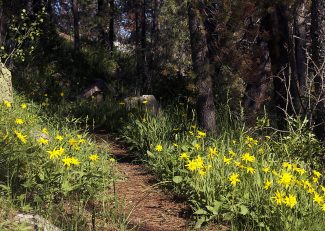Master Gardener: Botany with benefits — A ramble through Routt County’s medicinal plants
Master Gardener

Joel Reichenberger
Let’s face it: Routt County isn’t just a pretty face. Sure, our alpine meadows and sagebrush steppes are Instagram-worthy, but they’re also teeming with nature’s pharmacy—plants that have been healing bumps, bruises, bellies, and broken hearts long before your grandma’s chamomile tea came in fancy packaging.
So, put on your sunhat, grab a mug of dandelion root coffee, and wander with me through a few medicinal marvels of our mountain home.
1. Yarrow (Achillea millefolium): Nature’s First-Aid Kit Yarrow grows like gossip in a small town, everywhere and impossible to ignore. This feathery-leaved wonder earned the nickname “nosebleed plant” for its ability to stop bleeding. Historically used by soldiers (even Achilles, legend says), it’s also great in teas for colds and fevers.
2. Aspen (Populus tremuloides): Not Just a Pretty Bark Those shimmering leaves aren’t just cheering you on during your hike, aspens have pain-relieving powers, too. The inner bark contains salicylates, compounds similar to aspirin. Indigenous communities used it for pain, fever, and poultices. Just don’t peel bark from living trees. Let’s keep our forests tip top.
3. Wild Mint (Mentha arvensis): Trailside Breath Freshener Found along streams and meadows, wild mint is perfect for a mid-hike chew or calming tea. It soothes upset stomachs and smells like spa day in a cup. Be warned: it spreads faster in your garden than summer tourists on a bike trail.
4. Arnica (Arnica cordifolia): For When You Tried That “Easy” Hike Arnica is the go-to for sore muscles, bruises, and regrettable decisions involving uphill switchbacks Its bright yellow flowers resemble mountain daisies and are for external use only seriously. Slather, don’t sip.
5. Sagebrush (Artemisia tridentata): The Aromatic Overachiever Our pungent pal sagebrush is antimicrobial, antifungal, and anti-most-things-you-don’t-want. Burn it for ceremony, steep cautiously in tea, or simply admire its tenacity in dry, rocky soil.
Before You Brew… Before you dash off with a mason jar and a dream, remember, not all plants are safe for everyone. Some are toxic in high doses, some interact with medications, and some are just plain tricky to identify. Always consult a trusted guidebook or, better yet, your friendly local Master Gardener. (Office Hours: Thursdays 10:00–1:00 | (970)-879-0825 | rcextension@co.routt.co.us)
In Routt County, medicine grows underfoot, but so does respect. Harvest ethically, never overdo it, and remember that sometimes the best remedy is simply sitting still, soaking in the scent of sun-warmed wildflowers.
Happy (and healthy) trails!
About the Author: Sarah Storm grew up in a garden and never really left. She is the School Programs Manager at Yampatika and a first-year CSU Master Gardener apprentice, blending her love of education, ecology, and hands-in-the-dirt wisdom. She’s passionate about helping others rediscover the healing power of the natural world right outside their door.

Support Local Journalism

Support Local Journalism
Readers around Steamboat and Routt County make the Steamboat Pilot & Today’s work possible. Your financial contribution supports our efforts to deliver quality, locally relevant journalism.
Now more than ever, your support is critical to help us keep our community informed about the evolving coronavirus pandemic and the impact it is having locally. Every contribution, however large or small, will make a difference.
Each donation will be used exclusively for the development and creation of increased news coverage.








